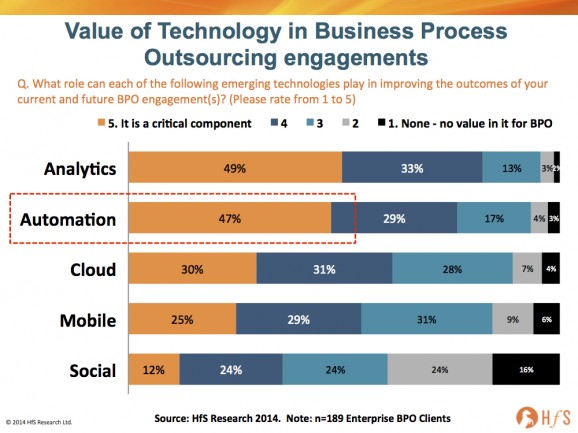We’re very shortly going to reveal the incredible findings (and they really are) of our new Technology in BPO study, and one of the key areas that jumps out at us is the rising importance of automation as a core value-driver for BPO clients.
As organizations seek to “cross the chasm” from a legacy labor arbitrage / staff augmentation model of business service delivery to a technology-enabled service experience that isn’t completely dependent on adding extra bodies to scale a service, the most immediate measure is to map out simple process workflows that humans are doing, and develop them in a software program using a process automation tool (and yes, I am trying to avoid using the term “robot” for now…).
Suddenly BPO clients discover, for example, that as sales of a particular product increase, they can scale their order management capability by replicating many of the human tasks processing those orders, as opposed to simply throwing more bodies at the problem. Many service providers will not be happy as this may well hurt their model of earning money through the supply of additional labor, but smart clients are already wisening up to the fact they need to get out of the FTE game. So, we asked HfS’ Charles Sutherland to share his views on what is really happening with process automation and why is shouldn’t be confused with technology automation theories of yesteryear…
We’ve seen it all before: IT suites, BPM Suites, customer service management tools etc. so how is this any different?
I came across a blog on automation by Somok Roy at ISG entitled “Lets Be Clear: Automation Is Not New Technology“. I couldn’t be more in agreement with the title, and its premise that the term “automation” is imprecise and a source of confusion. In fact, the blog is a case study in how automation can be misunderstood when approached as a lesson in IT history and not as a means to solve a set of current business problems.
So in the spirit of collegiality, I thought it would be useful to share some perspectives on why process automation is more than a surge of breathless marketing and less than the arrival of an entirely new outsourcing paradigm, but still a solution to many business problems. That’s why it is resonating with every enterprise client and every service provider we talk to today – and why two current market surveys we have in the field capture interest in automation as a solution to current business problems that is second only to analytics:
My take is that all these other forms of automation have certainly played a role in how IT and business processes are delivered inside clients and in service providers, but in many cases those tools are too hard to implement, over-engineered, too costly and – more often than not – fail to live up to their promise. If they were so great, we wouldn’t have had the creation of the “lights-on-outsourcing” industry that we have today or at least certainly not at the scale it has reached. Instead, we’ve had an FTE-dependent model for service delivery that, for a great many enterprises (and service providers) is losing its viability, as ongoing productivity gains prove harder to squeeze out of the status quo and COLA driven increases reduce the business benefits for all.
Process automation is new in that it doesn’t try to be as transformative as BPM Suites or as dependent on deep tech skills as past IT infrastructure automation tools. Instead, these new breed of tools, such as Blue Prism, IPSoft and UiPath, are meant to be used by business analysts working on small-to-medium sized projects so that they can replicate the process done today by a human, by setting up a software-based equivalent instead. When that occurs, it becomes possible to reduce costs further, pilot additional new productivity improvements and make these changes quickly, whether in the enterprise location and or in a service providers delivery center. To me, actually achieving process automation quickly, with lower net costs and without the overhead of a broad transformative effort seems like something new. That their interfaces are user friendly and you can readily apply them, even in the sort of Citrix-based processing environments many BPOs use today, also suggests that they are something new. I’m not a developer by any means and so when I can use them to replicate simple processes with only a minimal level of training, then that also suggests that there might be something new in this as well.
The Bottom-line: Automation projects can provide those first baby-steps away from the FTE-model
They are a step in the journey, especially for enterprises that aren’t in a position to swap out their enterprise applications, but are looking for something more than they can achieve by merely hurling incremental labor at a process.

Charles Sutherland (pictured left) is Executive Vice President, Research at HfS
Now here is where the breathlessness has occurred so far…. these tools don’t eliminate the value of all the other automation capabilities out there.
So, if you step back and don’t try to confuse this emerging capability in process automation with other forms of the term covering BPM, analytics and infrastructure monitoring, then maybe, just maybe it will be a little clearer why this is an important trend in business services delivery in 2014+.
Charles Sutherland is author of “Framing a Constitution for Robotistan“, which you can download here.
Posted in : Business Process Outsourcing (BPO), Cloud Computing, HfS Surveys: Technology in BPO 2014, HfSResearch.com Homepage, HR Strategy, IT Outsourcing / IT Services, Robotic Process Automation, smac-and-big-data, Sourcing Best Practises, sourcing-change, the-industry-speaks








Charles – excellent points.
Which services providers are leading in the automation space?
Alex Chalmers
Some very interesting observations, which I agree with. The comment about providers losing money from automation is especially interesting. Do you see many of them resisting offering clients support in this area?
… [Trackback]…
[…] Read More Infos here: horsesforsources.com/process_automation_020814 […]…
Alex – At this point, I wouldn’t declare any specific service providers to be leading. They are all thinking about it and some are more aggressive in publishing points of view or blogging (e.g. HP, Sutherland GS, TCS and others…) but until we see the first big client announcements where process automation was a core factor in the solution it’s hard to crown a winner.
Gaurav – I don’t see anyone resisting clients openly although with still a limited experience pool of solution architects, deployment teams, business analysts in each service provider who are versed in the new tools, it may feel that way for clients who start asking but don’t yet have access to those scarce resources.
Charles
Charles,
Excellent article! The questions we’re hearing from clients regarding automation are;
1) Are there sufficient reference accounts relative to my business?
2) What does this mean for my existing service contracts?
3) What should I be expecting of the market as I put services out to bid?
I’m looking forward to the publication of the rest of your study.
Kevin
[…] the entire post: http://www.horsesforsources.com/process_automation_020814 Share page:EmailPrintLinkedInTwitterFacebookGoogle […]
Nice article Charles.
1. In BPO clients, where process standardization has not happened (or perenially in planning stage) – Wouldn’t this lead to huge maintenance cost of the Automated components – Will the RoI be justified in such cases
2. How do you think pricing structure will change in future with Automation as key lever.
@ Smilie and @Lakshmanan
At this point we haven’t really seen the reference clients emerge. I am expecting to see the first of these by June of this year given where the early mobilization and deployments are.
We’re probably a year or more out from this broadly impacting large existing contracts although if you have one which is up for renewal in the next 12-18 months I would expect to see either your incumbent or a competitive service provider begin to talk to you about this before the end of 2014.
If you put something out to bid today, it is hit or miss whether this will be a significant part of a service provider response. The number of solution architects, sales teams and frankly third party advisors who fully “get” this and are building it into bids or even the RFPs in the case of advisors remains small still but is growing each month.
This doesn’t need to have a multi-client standardized process to work. In fact some of the best ROI cases I have seen so far are when the existing process is very unique to a single client but where there is scale in the operations and the risks of errors or non-compliance in processing due to human effort is substantial.
I fully believe that automation will drive a much greater push on the part of the service providers towards fixed price contracts.
[…] Automation: it’s about solving business problems, stupid! […]